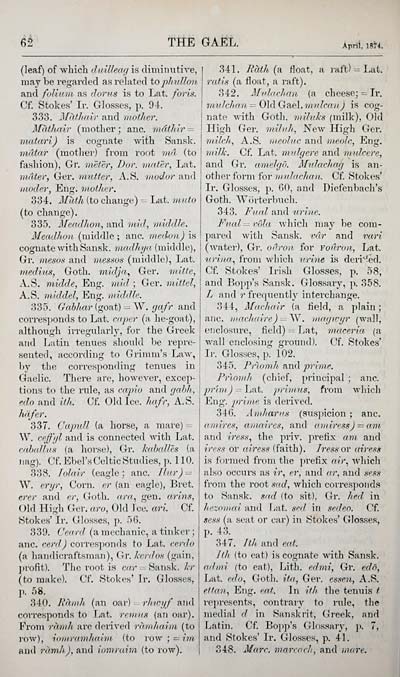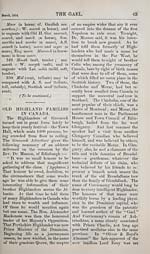Hew Morrison Collection > Gaidheal > Volume 3
(36)
Download files
Complete book:
Individual page:
Thumbnail gallery: Grid view | List view

62
THE GAEL.
Aprii, 1874.
(leaf) of which duilkmi is dimiiuitive,
may be regarded as related tojyhullon
and folinm as dorus is to Lat. foris.
Cf. Stokes' Ir. Glosses, p. 94.
333. MàtÌKiir and motlier.
Màthair (mother; anc. mdthir^
maiar'i) is cognate with Sansk.
mdtar (mother) from root md (to
fashion), Gr. meter, Dor. mdtèr, Lat.
liiiUer, Ger. mutter, A.S. mudor and
moder, Eng. iiwtiier.
334. Math (to change) ^ Lat. inxto
(to change).
335. Meadhon, and 9/m/, middle
Meadhon (middle ; anc. medon) is
cognate with Sansk. inadhya (middle),
Gr. mesos and liiessos (middle), Lat.
iimlim, Goth, tnldja, Ger. ■?»77^e,
A.S. midde, Eng. «;,n? ; Ger. mittel,
A.S. luiddel, Eng. middle.
335. Gabhar igofit) = W. rjq/r and
corresjionds to Lat. rr/^^t?' (a, he-goat),
although irregularly, for the Greek
and Latin tenues should he repre-
sented, according to Grimm's Law,
l)y the corresponding tenues in
Gaelic. There are, however, excep-
tions to the rule, as cajno and r/nbh,
■'do and il/i. Cf. Old Ice. />ii/r, A.S.
hafer.
337. Capnll (a horse, a mare) ^
W. reff'i/l and is connected with Lat.
r(di(dliiH (a horse), Gr. ladudlcs (a
nag). Cf. Ebel's Celtic Studies, p. 110.
338. lolair (eagle ; anc. liar) -■=
W. erijr, Corn, er (an eagle), Bret.
erer and e.r, Goth, ara^ gen. arins,
Old High Ger. aro. Old Ice. «r/. Cf.
Stokes' L-. Glosses, p. 56.
339. Ceard (a mechanic, a tinker ;
anc. cerd ) corresjionds to Lat. cerdo
(a handicraftsman), Gr. kcrdon (gain,
jirofit). The root is ear Sansk. I,r
(to make). Cf. Stoki's' Ir. Glosses,
p. 58.
340. Jìàm/i, (an oar) rha-njf and
corresponds to Lat. rniiaa (an oar).
Froni ràììih are dinived ràmliaim (to
I'ow), iomravìludìa. (to row ; = wt
and ràmh), and iomraim (to row).
' 341. Rath {'A Hoat, a raft) = Lat.
ratis (a float, a raft).
342. Mahii-licui (a cheese; = L-.
7/;?'/c/'o/i = Old Gael. 7/???/cfr»^ is cog-
nate with Goth, miluhs (milk), Old
High Ger. milah, New High Ger.
inilcJi, A.S. meolac and iiieolr, Eng.
■?»?'tt'. Cf. Lat. mxlgere and vialcere,
and Gr. amehjo. MnJacharj is an-
other form for mulachan. Cjf. Stokes'
Ir. Glosses, p. 60, and Diefenbach's
Goth. Wiirterbuch.
343. Faal and urine.
Faal—rola which may be com-
pared with Sansk. vdr and vari
(water), Gr. odron for Fom'on, Lat.
iirina., from which vrine is deri^!ed.
Cf. Stokes' Irish Glosses, p. 58,
and Bopp's Sansk. Glossary, p. 358.
L and r freipiently interchange.
344. Murlialr (a field, a plain ;
anc. inacha!re) = y^^. iiiagwijr (wall,
enclosure, field) = Lat, maceria (a
wall enclosing ground). Cf. Stokes'
Ii-. Glosses, p. 102.
345. J'r)omIi and prime.
J'r)oi/ih (cliief, principal ; anc.
priiaj h:it. /niiiias, from wliich
Eng. jiriijie is derived.
346. Am/iaras (susi)icion ; anc.
a /a ires, amaires, and aitan'ssj = crm
and iress.1 the priv. prefix atii and
iress or airess (faith), /rest; or aii-ess
is formed from the jn'efix air, which
also occurs as ir, er, and ((r, and sests
from the root .w(/, which corresponds
to Sansk. ,iad (to sit), Gr. /ted in
/ler.oijiai and r^at. seil in sedeo. Cf.
se.sn (a seat or cai-) in Stokes' Glosses,
p. 43.
347. /th and eat.
Jth (to eat) is cognate with Sansk.
admi (to eat), Lith. edmi, Gr. edo,
Lat. edo, Goth, ita, Ger. ensen, A.S.
ettan, Eng. w^. In vVA the tenuis t
represents, contrary to rule, the
medial d in Sansk i-it, Greek, and
Latin. Cf. Bopji's GHossary, p. 7,
and Stokes' Ir. Glosses, p. 41.
348. Marc, manacli, and mare.
THE GAEL.
Aprii, 1874.
(leaf) of which duilkmi is dimiiuitive,
may be regarded as related tojyhullon
and folinm as dorus is to Lat. foris.
Cf. Stokes' Ir. Glosses, p. 94.
333. MàtÌKiir and motlier.
Màthair (mother; anc. mdthir^
maiar'i) is cognate with Sansk.
mdtar (mother) from root md (to
fashion), Gr. meter, Dor. mdtèr, Lat.
liiiUer, Ger. mutter, A.S. mudor and
moder, Eng. iiwtiier.
334. Math (to change) ^ Lat. inxto
(to change).
335. Meadhon, and 9/m/, middle
Meadhon (middle ; anc. medon) is
cognate with Sansk. inadhya (middle),
Gr. mesos and liiessos (middle), Lat.
iimlim, Goth, tnldja, Ger. ■?»77^e,
A.S. midde, Eng. «;,n? ; Ger. mittel,
A.S. luiddel, Eng. middle.
335. Gabhar igofit) = W. rjq/r and
corresjionds to Lat. rr/^^t?' (a, he-goat),
although irregularly, for the Greek
and Latin tenues should he repre-
sented, according to Grimm's Law,
l)y the corresponding tenues in
Gaelic. There are, however, excep-
tions to the rule, as cajno and r/nbh,
■'do and il/i. Cf. Old Ice. />ii/r, A.S.
hafer.
337. Capnll (a horse, a mare) ^
W. reff'i/l and is connected with Lat.
r(di(dliiH (a horse), Gr. ladudlcs (a
nag). Cf. Ebel's Celtic Studies, p. 110.
338. lolair (eagle ; anc. liar) -■=
W. erijr, Corn, er (an eagle), Bret.
erer and e.r, Goth, ara^ gen. arins,
Old High Ger. aro. Old Ice. «r/. Cf.
Stokes' L-. Glosses, p. 56.
339. Ceard (a mechanic, a tinker ;
anc. cerd ) corresjionds to Lat. cerdo
(a handicraftsman), Gr. kcrdon (gain,
jirofit). The root is ear Sansk. I,r
(to make). Cf. Stoki's' Ir. Glosses,
p. 58.
340. Jìàm/i, (an oar) rha-njf and
corresponds to Lat. rniiaa (an oar).
Froni ràììih are dinived ràmliaim (to
I'ow), iomravìludìa. (to row ; = wt
and ràmh), and iomraim (to row).
' 341. Rath {'A Hoat, a raft) = Lat.
ratis (a float, a raft).
342. Mahii-licui (a cheese; = L-.
7/;?'/c/'o/i = Old Gael. 7/???/cfr»^ is cog-
nate with Goth, miluhs (milk), Old
High Ger. milah, New High Ger.
inilcJi, A.S. meolac and iiieolr, Eng.
■?»?'tt'. Cf. Lat. mxlgere and vialcere,
and Gr. amehjo. MnJacharj is an-
other form for mulachan. Cjf. Stokes'
Ir. Glosses, p. 60, and Diefenbach's
Goth. Wiirterbuch.
343. Faal and urine.
Faal—rola which may be com-
pared with Sansk. vdr and vari
(water), Gr. odron for Fom'on, Lat.
iirina., from which vrine is deri^!ed.
Cf. Stokes' Irish Glosses, p. 58,
and Bopp's Sansk. Glossary, p. 358.
L and r freipiently interchange.
344. Murlialr (a field, a plain ;
anc. inacha!re) = y^^. iiiagwijr (wall,
enclosure, field) = Lat, maceria (a
wall enclosing ground). Cf. Stokes'
Ii-. Glosses, p. 102.
345. J'r)omIi and prime.
J'r)oi/ih (cliief, principal ; anc.
priiaj h:it. /niiiias, from wliich
Eng. jiriijie is derived.
346. Am/iaras (susi)icion ; anc.
a /a ires, amaires, and aitan'ssj = crm
and iress.1 the priv. prefix atii and
iress or airess (faith), /rest; or aii-ess
is formed from the jn'efix air, which
also occurs as ir, er, and ((r, and sests
from the root .w(/, which corresponds
to Sansk. ,iad (to sit), Gr. /ted in
/ler.oijiai and r^at. seil in sedeo. Cf.
se.sn (a seat or cai-) in Stokes' Glosses,
p. 43.
347. /th and eat.
Jth (to eat) is cognate with Sansk.
admi (to eat), Lith. edmi, Gr. edo,
Lat. edo, Goth, ita, Ger. ensen, A.S.
ettan, Eng. w^. In vVA the tenuis t
represents, contrary to rule, the
medial d in Sansk i-it, Greek, and
Latin. Cf. Bopji's GHossary, p. 7,
and Stokes' Ir. Glosses, p. 41.
348. Marc, manacli, and mare.
Set display mode to: Large image | Transcription
Images and transcriptions on this page, including medium image downloads, may be used under the Creative Commons Attribution 4.0 International Licence unless otherwise stated. ![]()
| Early Gaelic Book Collections > Hew Morrison Collection > Gaidheal > Volume 3 > (36) |
|---|
| Permanent URL | https://digital.nls.uk/76803523 |
|---|
| Shelfmark | H.M.36 |
|---|---|
| Attribution and copyright: |
|
| Description | A selection of items from a collection of 320 volumes and 30 pamphlets of literary and religious works in Scottish Gaelic. From the personal library of Hew Morrison, the first City Librarian of Edinburgh. |
|---|
| Description | Selected items from five 'Special and Named Printed Collections'. Includes books in Gaelic and other Celtic languages, works about the Gaels, their languages, literature, culture and history. |
|---|

